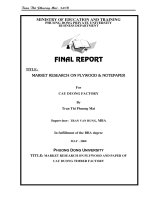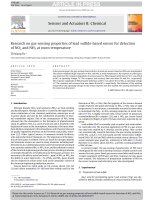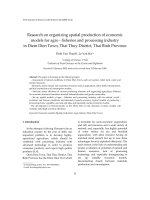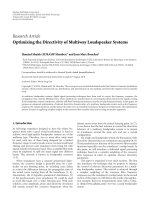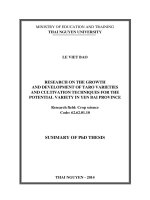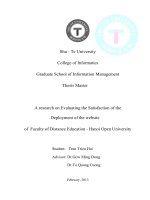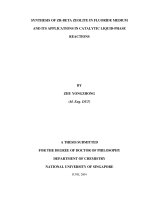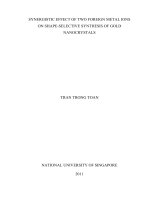Research on optimizing the synthesis of ammonium dinitramide
Bạn đang xem bản rút gọn của tài liệu. Xem và tải ngay bản đầy đủ của tài liệu tại đây (790.16 KB, 8 trang )
Hóa học & Mơi trường
Research on optimizing the synthesis of ammonium dinitramide
Pham Quang Hieu*, Bui Anh Thuc, Nguyen Duc Long, Pham Kim Dao
Institute of Propellant and Explosives.
*
Coressponding author:
Received 20 Sep 2022; Revised 11 Nov 2022; Accepted 12 Dec 2022; Published 28 Dec 2022.
DOI: />
ABSTRACT
Ammonium dinitramide (ADN) is one of the potential oxidants in solid propellant formulations
because it is environmentally friendly, has a high specific impulse, and has minimum signature
exhaust gases. ADN was synthesized through the nitration reaction of potassium sulfamate salt
with a mixture of sulfuric acid and nitric acid. The optimal conditions for the synthesis were
studied, such as the ratio of components, reaction temperature, and reaction time. Specifically, the
nitration reaction temperature was -40 oC, the ntration reaction time was 30 minutes, the molar
ratio of potassium sulfamate, sulfuric acid, and nitric acid was 1, 2.5, and 9, respectively, and the
molar ratio of potassium dinitramide to ammonium sulfate of 1: 1.1.
Keywords: Ammonium dinitramide; Potassium dinitramide; ADN; KDN; KS.
1. INTRODUCTION
Ammonium dinitramide (ADN), NH4N(NO2)2, is a relatively newly discovered energetic
ionic salt, which is of considerable interest as a potential eco-friendly oxidizing component of the
future solid propellant formulation. On the other hand, ammonium perchlorate (AP) is the
standard, widely used oxidizer in composite solid propellants. The disadvantage of AP is that its
chlorinated exhaust products are harmful to the environment and produce a distinct signature
behind missiles that can be easily detected. In addition, perchlorate may cause thyroid cancer by
contaminating soil and water [1]. AP produces the toxic HCl acidic plume (generated during AP
combustion), an acid known to be detrimental to the earth’s ozone layer [2].
ADN mainly consists of nitrogen (N), oxygen (O), and hydrogen (H) in its molecular
structure. Hence, the combustion products of ADN are harmless to the environment. Further, the
presence of dinitramide anion [N(NO2)2 - ] imparts high density, high heat of formation, high
oxygen balance, and high oxygen content. Therefore, ADN is one of the capable oxidizers with
high specific impulse (Isp) and high burning rate [3, 4]. From the above issues, ADN has thus
been considered a potential replacement oxidizer for AP in propellant formulations. Thus, ADN
has created significant interest in recent years. However, synthesizing energetic, halogen-free
materials like ADN in high yield and purity is one of the challenging tasks.
There are many ways of synthesizing ADN, but the synthesis method through the
intermediate compound is potassium dinitramide (KDN, KN(NO2)2) for high efficiency,
convenience, and economic savings [5, 6]. This way, KDN is synthesized from the nitration of
potassium sulfamate salt with a mixture of sulfuric acid and nitric acid at temperatures lower
than -25 oC. The reactions take place according to the following equation:
50
P. Q. Hieu, …, P. K. Dao, “Research on optimizing the synthesis of ammonium dinitramide.”
Nghiên cứu khoa học công nghệ
In this paper, we studied the modulation of ADN under domestic conditions. The research
results aim to establish the optimal synthesis process conditions for the highest performance
under laboratory conditions.
2. EXPERIMENTAL SECTION
2.1. Materials
The chemicals used include sulfamic acid, potassium hydroxide, ethanol, sulfuric acid, fuming
nitric acid, ammonium sulfate, isopropanol, and acetone. All chemicals used were of AR grade.
2.2. Equipments and tools
IKA's reactor system consists of a double walled
reactor vessel made from SUS316 stainless steel,
connected to a Julabo deep negative cooling system to
regulate temperature (figure 1); Heidolp vacuum rotary
evaporator; Infrared spectrometer: Perkin Elmer's FT-IR
Spectrum
Two;
Ultraviolet-Visible
(UV-Vis)
spectrophotometer: Perkin Elmer Lambda 365; Nuclear
magnetic resonance (NMR) spectrometer: Brucker
Avance 600 MHz spectrometers; X-ray diffraction
spectrometer: Panalytical X’pert Pro MRD.
2.3. Analytical methods
Figure 1. IKA's reactor system.
2.3.1. FTIR spectroscopy method
The FTIR spectroscopy method was used to determine the characteristic functional groups of
the synthesized products. Synthetic products were mixed with KBr, compressed into pellets, and
measured on a Perkin Elmer FT-IR Spectrum Two infrared spectrometer.
2.3.2. UV-Vis spectroscopy method
The UV-Vis spectroscopy method was used to determine the characteristic wavelengths of the
ADN product. The ADN synthesis product was dissolved in water at a concentration of 10 mg/l
and measured on a UV-Vis spectrophotometer Perkin Elmer Lambda 365.
2.3.3. NMR spectroscopy method
The NMR spectroscopy method was used to determine the structure of the synthesized
compounds. 1H NMR spectra: δ (H) are given in ppm relative to tetramethylsilane (TMS), using
δ (acetone-d6) = 2.05 ppm as the internal reference.
2.3.4. Powder X-ray diffraction
The powder X-ray diffraction (PXRD) patterns of ADN and KDN were determined based on
Cu-Kα radiation using a Panalytical X’pert Pro MRD, which operated at 40 kV and 35mA. The
data of samples were collected at a scan rate of 0.5 s per step over the range of 10°–80° (step
size: 0.03°).
2.4. Preparation of potassium sulfamate (KS)
100 g of sulfamic acid and 50 ml of water were suspended in a 500 ml beaker. 60 g of
potassium hydroxide was dissolved in 50 ml of water. Then the potassium hydroxide solution
was added slowly to the beaker containing sulfamic acid and the suspension until pH = 7 was
reached. The solution was then poured into a beaker containing 100 ml of ethanol. A white
precipitate appeared and was filtered off with a Buchner funnel, washed with alcohol and dried at
70 °C to obtain a white salt (KS). After drying, the salt was ground, and crushed into a fine
powder in a porcelain mortar. M.p: 218.4 - 220 oC, yield: 95.7%.
2.5. Preparation of potassium dinitramide (KDN)
Tạp chí Nghiên cứu KH&CN quân sự, Số 84, 12 - 2022
51
Hóa học & Mơi trường
110 ml of fuming nitric acid (98%) and 40 ml of sulfuric acid (98%) were placed into the IKA
reactor system reactor vessel. As soon as the reaction vessel temperature reached -40 oC, 40 g of
potassium sulfamate was placed slowly into the acid mixture for 15 minutes. After adding the
potassium sulfamate, stir the mixture vigorously for 30 minutes. The mixture's viscosity
increased as the reaction occurred, and a white precipitate appeared. The reaction mixture was
then poured into a beaker containing 400 g of finely ground ice. The reaction mixture was
neutralized by slowly adding a solution of potassium hydroxide (50%) to maintain the mass
reaction temperature between -10 oC and 0 °C. When approaching the neutral point, the color of
the mixture turned into a specific yellow-green color. When the pH of the reaction solution
reached the point between 7 and 8, the neutralization process stopped. The formed precipitate
was then filtered off with a Buchner funnel and washed with 80 ml of water. The filtered solution
was then evaporated to a quarter of its volume by the evaporator and was allowed to cool to
room temperature. The precipitated salts were filtered off and washed with 50 ml of water. The
filtrate was evaporated to dryness to obtain a solid mixture. The mixture of these salts was
extracted with 150 ml of acetone. The extract was evaporated using a rotary evaporator until
obtaining a pale-yellow solid (KDN). The obtained KDN was dried at 60 oC to constant weight.
Mp: 128.1 - 129.3 oC, yield: 50.4%.
2.6. Synthesis of ammonium dinitramide (ADN)
10 g of potassium dinitramide and 11.5 g of ammonium sulfate were each dissolved
separately into 10 ml of water. The solutions were mixed and stirred for 30 minutes. 100 ml of
isopropanol was added to the mixture, then a white precipitate appeared and was filtered off with
a glass funnel. The filtrate was evaporated on a rotary vacuum evaporator until a white solid
(ADN) was obtained. This solid was dried at 50 oC until the mass remained constant. Mp: 92.1 93.5 oC, yield: 92.1%.
3. RESULTS AND DISCUSSION
3.1. Effect of reaction temperature on KDN synthesis yield
To determine the optimum temperature during the nitration of potassium sulfamate with a
mixture of nitric and sulfuric acids. The research team performed the nitration reaction at
different temperatures in a reaction time of 30 minutes. The results of the dependence of KDN
yield on reaction temperature are presented in table 1 and figure 2.
Table 1. The dependence of KDN yield on reaction temperature.
Reaction temperature, oC
-20 oC
-30 oC
-35 oC
-40 oC
-45 oC
-50 oC
Yield, %
10.1
30.3
40.6
50.4
35.5
20.5
Yield, %
60
50
40
30
20
10
0
-60
-40
-20
0
Temperatures, oC
Figure 2. The dependence of KDN yield on reaction temperature.
It can be seen that the reaction efficiency was highest at -40 oC (figure 2 and table 1). This
52
P. Q. Hieu, …, P. K. Dao, “Research on optimizing the synthesis of ammonium dinitramide.”
Nghiên cứu khoa học công nghệ
can be explained as follows: during the process, two competing exothermic reactions occurred,
namely the nitration of potassium sulfamate and the decomposition of the product. While
conducting the reaction at -20 oC, the nitration reaction occurred quickly, but the product also
decomposed fast, so the synthesis efficiency was very low. According to some studies, the
decomposition temperature of the product occurred rapidly at temperatures higher than -25 oC
[3]. Therefore, the yield at -30 oC was lower than at -40 oC, because the decomposition of the
product occurred faster. At -50 °C, the product was also stable. However, the yield was much
lower because the low temperature led to the high viscosity of the reaction mixture, thus causing
difficulty separating the heat generated in the reaction [5]. This caused local overheating of the
reaction mixture and rapid decomposition of the products.
3.2. Effect of reaction time on KDN synthesis efficiency
The nitration process's reaction time was calculated from when all the potassium sulfamate
was added to the acid mixture. To optimize the reaction time, the authors carried out the nitration
reaction at -40 oC and maintained the reaction for 5 minutes, 15 minutes, 30 minutes, 45 minutes,
and 60 minutes. The results are shown in table 2 and figure 3.
Table 2. The dependence of KDN yield on reaction time.
Reaction time, min
Yield, %
Yield, %
5
15
30
45
60
15.3
30.6
50.4
45.2
40.7
60
50
40
30
20
10
0
0
20
40
60
80
Time, min
Figure 3. The dependence of KDN yield on reaction time.
We see that the highest efficiency achieved was 50.4%, with a reaction time of 30 minutes.
When the reaction time was increased from 5 minutes to 30 minutes, the reaction efficiency
increased because the nitration process took place completely. At -40 oC, the product
decomposition process was slow, so when the nitration reaction occurred utterly, the product
decomposition reaction started to take place strongly. As a result, the yield began to decrease
when the reaction time was increased to more than 30 minutes. This decrease was entirely
consistent with the effect of temperature on the synthesis performance.
3.3. Study on the effect of the ratio of acid mixture on the synthesis efficiency of KDN
The nitration of potassium sulfamate is the crucial stage in preparing potassium dinitramide.
The nitration agent for KDN synthesis is a mixture of sulfuric acid and nitric acid, and the
nitration mechanism of acidic mixtures is due to the formation of nitronium ions. The formation
of these nitronium ions depends on the amount of sulfuric acid and nitric acid. Therefore, the
nitration step was modified by varying the quantity and ratio of the acids used. Based on some
published documents [5, 6], the team fixed the volume ratio of the sulfuric acid to nitric acid of
1: 2.75 (nHNO3: nH2SO4 = 3.6 : 1) and varied the mass ratio of the acid mixture to KS to
evaluate the effect of the ratio of components on the KDN synthesis efficiency. The results are
presented in figure 4.
Tạp chí Nghiên cứu KH&CN quân sự, Số 84, 12 - 2022
53
Hóa học & Mơi trường
60
Yield, %
50
40
30
20
10
0
4
5
6
7
8
The mass ratio of the acid mixture/KS
Figure 4. The dependence of KDN yield on quantity of acid mixture.
From the data in figure 4, we found that when the mass ratio of acid mixture to potassium
sulfamate was raised from 4.5 to 6, the reaction efficiency increased from 35.1% to 50.4%.
However, the efficiency was almost unchanged when increasing acid mixture. From here, it can
be seen that the excess amount of acid mixture did not significantly affect efficiency. However, when
the quality of acid mixture decreased to 25%, the efficiency decreased by 15.3%.
The quantity of sulfuric acid and its effect on the nitration yield at a constant molar
ratio of potassium sulfamate to nitric acid (nHNO3 : nKS = 9 : 1) was also studied.
The results of these measurements are shown in figure 5.
Yield, %
55
50
45
40
35
1
2
3
4
nH2SO4 (mol)
Figure 5. The effect of sulfuric acid quantity on the yield nitration.
The highest yield was noted with moles of sulfuric acid of 2.5 mol. When reducing the
amount of sulfuric acid, the activity of the nitrate mixture was reduced, leading to a lower
nitration efficiency. Conversely, a large amount of sulfuric acid also adversely affected the
nitration performance because it may have increased the mixture's viscosity at low temperatures.
This led to an increase in the local temperature of the reaction mixture. This increase caused the
decomposition of the product to take place rapidly. Therefore, we determined that the optimal
molar ratio of potassium sulfamate to sulfuric acid to nitric acid of 1 : 2.5 : 9. On the other hand, a
lowered sulfuric acid quantity reduced the waste potassium sulfate formed and the amount of
potassium hydroxide used to neutralize.
3.4. Study on the effect of the ratio of components on the synthesis efficiency of ADN
At room temperature, ADN was obtained from KDN and ammonium sulfate by cation
exchange. To study the effect of the ratio of components on the synthesis efficiency of ADN, we
carried out many reactions with the change in the molar ratio of KDN to (NH 4)2SO4. The results
of the dependence of ADN yield on the ratio of components are presented in figure 6.
It was found that the reaction yield was not significantly affected by increasing the molar
ratio of (NH4)2SO4 to KDN by more than 1 (figure 6). Moreover, more unwanted products, such as
54
P. Q. Hieu, …, P. K. Dao, “Research on optimizing the synthesis of ammonium dinitramide.”
Nghiên cứu khoa học công nghệ
Yield, %
potassium sulfate, were created when increasing the amount of ammonium sulfate. Therefore, the
optimal molar ratio of (NH4)2SO4 to KS for the ADN synthesis reaction was 1.1.
94
92
90
88
86
84
82
80
0.5
0.7
0.9
1.1
1.3
1.5
The molar ratio of (NH4)2SO4 to KDN
Figure 6. The dependence of ADN yield on the ratio of components.
3.5. Features of the product of KDN, ADN synthesis
The synthesis product (ADN) is a white solid with a melting point of 92.1 - 93.5 oC and a
density of 1.82 g/cm3. The synthesized products were dried and measured by FTIR, UV-Vis, 1H
NMR spectra and XRD pattern.
Figure 8. FTIR spectrum of ADN.
Figure 7. FTIR spectrum of KDN.
Table 3. Major FTIR peaks for KDN, ADN and their assignments.
Wavenumber (cm-1)a
KDN
ADN
3128 b
1529 s
1537 s
1400 sh
1344 w
1343 w
1206 w
1179 vs
1177 vs
1023 s
1021 s
951 sh
952 sh
827 mw
827 mw
761 m
761 m
731 m
731 m
489 w
489 w
Assignmentsb
s NH4+ in phase
as NO2 in phase
δ sciss NH4+ out of phase
s NO2 in phase
s NO2 in phase
s NO2 in phase
as N3
s N3
δ sciss NO2 in phase
δ sciss NO2 out of phase
δ rock NO2 out of phase
δ wag NO2 out of phase
a
: s (strong); b (broad); sh (sharp); v (various); m (medium); w (weak).
: , δ are stretching, bending vibrations, respectively; s, as are symetric, asymestric stretch, respectively.
b
Tạp chí Nghiên cứu KH&CN quân sự, Số 84, 12 - 2022
55
Hóa học & Mơi trường
Figure 9. 1H NMR spectrum of ADN.
The 1H-NMR spectrum of ADN displayed a simple at 7.48 ppm (4H) corresponding to
NH4+ protons.
Figure 10. UV-Vis spectrum of ADN.
The UV-Vis spectrum of the synthesized product has two peak positions at wavelengths of
215.1 nm and 284.7 nm. These are characteristic peaks of the dinitramide ion. These peaks prove
that the product contains dinitramide ions.
Figure 11. XRD pattern of ADN.
56
Figure 12. XRD pattern of KDN.
P. Q. Hieu, …, P. K. Dao, “Research on optimizing the synthesis of ammonium dinitramide.”
Nghiên cứu khoa học công nghệ
The XRD pattern of ADN has characteristic peaks at angles 2θ of 15.055, 17.845, 27.115,
30.025, and 39.745. All the data of analysis of 1H NMR, FT-IR, UV-Vis, XRD agree with the
reported data in the literature [7-10].
4. CONCLUSIONS
In summary, ADN was synthesized through the intermediate compound KDN with a total
yield of 46%. KDN was prepared from the nitration of potassium sulfamate using a sulfuric acid/
nitric acid mixture. We have found that the optimal condition of ADN synthesis was at a
nitration temperature of -40 oC, the nitration reaction time was 30 minutes, the molar ratio of KS
to H2SO4 to HNO3 of 1 : 2.5 : 9 and the molar ratio of KDN to (NH4)2SO4 of 1 : 1.1.
REFERENCES
[1]. Urbansky, Edward Todd, "Perchlorate as an environmental contaminant," Environmental Science
and Pollution Research, Vol 9, No.3, pp. 187-192, (2002).
[2]. Larsson, Anders, and Niklas Wingborg, "Green propellants based on ammonium dinitramide
(ADN)," Advances in Spacecraft Technologies 2, pp. 139-156, (2011).
[3]. Kumar, Pratim, "An overview on properties, thermal decomposition, and combustion behavior of ADN
and ADN based solid propellants," Defence technology Vol. 14, No. 6, pp. 661-673, (2018).
[4]. Venkatachalam, Subbiah, Gopalakrishnan Santhosh, and Kovoor Ninan Ninan, "An overview on the
synthetic routes and properties of ammonium dinitramide (ADN) and other dinitramide salts," Propellants,
Explosives, Pyrotechnics: An International Journal Dealing with Scientific and Technological Aspects of
Energetic Materials, Vol. 29, No. 3, pp.178-187, (2004).
[5]. Nazeri, Gh H., Nia M. Fayaz, And Ghobadi P. Key, "Synthesis of ammonium dinitramide by nitration
of potassium and ammonium sulfamate. The effect of sulfamate conterion on ADN purity,"
Iran.J.Chem.Chem. Eng, Vol 27, No 1, pp. 85-89, (2008).
[6]. Gołofit, Tomasz, Paweł Maksimowski, and Ariel Biernacki, "Optimization of potassium dinitramide
preparation," Propellants, Explosives, Pyrotechnics, Vol.38, No. 2, pp. 261-265, (2013).
[7]. Östmark, H., et al, "The properties of ammonium dinitramide (ADN): part 1, basic properties and
spectroscopic data," Journal of Energetic Materials, Vol.18, No.2-3, pp. 123-138, (2000).
[8]. Oliveira, José Irineu Sampaio de, et al, "Assessment of the synthesis routes conditions for obtaining
ammonium dinitramide by the FT-IR," Journal of Aerospace Technology and, Vol.3, pp. 269-278, (2011).
[9]. Qiao, Shen, Hong-zhen Li, and Zong-wei Yang, "Decreasing the hygroscopicity of ammonium
dinitramide (ADN) through cocrystallization," Energetic Materials Frontiers, (2022).
[10]. Herrmann, Michael, Ulrich Förter‐Barth, and Thomas Heintz, "Melt Crystallization of Ammonium
Dinitramide (ADN) Investigated by Means of X‐ray Diffraction," Chemie Ingenieur Technik, Vol. 93,
No. 8, pp. 1295-1299, (2021).
TĨM TẮT
Nghiên cứu tối ưu q trình tổng hợp amoni dinitramit
Amoni dinitramit (ADN) là một trong những chất oxy hóa tiềm năng cho nhiên liệu tên
lửa rắn vì nó thân thiên mơi trường, có xung lực đẩy riêng cao và có ít khí thải đặc trưng.
ADN được tổng hợp thơng qua phản ứng nitro hóa muối kali sunfamat bằng hỗn hợp axit
sunfuric và axit nitric. Các điều kiện tối ưu cho quá trình tổng hợp đã được nghiên cứu
như tỷ lệ các thành phần, nhiệt độ phản ứng, thời gian phản ứng. Trong đó, nhiệt độ phản
ứng nitro hóa là -40 oC, thời gian phản ứng 30 phút, tỷ lệ mol kali sunfamat, axit sunfuric
và axit nitric lần lượt là 1, 2.5, 9 và tỷ lệ mol kali dinitramit, amoni sunfat là 1 : 1.1.
Từ khóa: Amoni dinitramit; Kali dinitramit; ADN; KDN; KS.
Tạp chí Nghiên cứu KH&CN quân sự, Số 84, 12 - 2022
57
